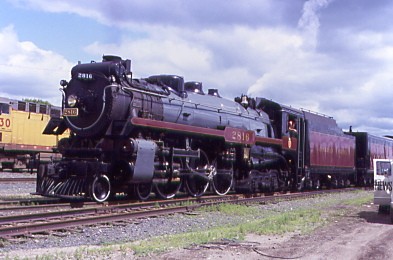
Built by the Montreal Locomotive Works in December 1930, it is the only non-streamlined Hudson to be preserved. The locomotive was primarily used in pulling passenger trains in revenue service for thirty years before it was retired in May 1960. In 1963, it was sold to F. Nelson Blount, who added it to his Steamtown, U.S.A. collection in Bellows Falls, Vermont. After becoming surplus in the collection by the National Park Service, 2816 was reacquired by the Canadian Pacific in 1998 and crews from BC Rail were hired to extensively restore it to operating condition.
Revenue serviceIt was first assigned to premier passenger service between Winnipeg and Fort William, Ontario. Following the introduction of semi-streamlined Royal Hudson locomotives in 1937, it was re-assigned to secondary passenger service between Windsor, Ontario and Quebec City and during the 1950's, it pulled commuter trains between Montreal and Rigaud, Quebec. In 1957, 2816 received a minor overhaul, with its tender being replaced with one from Royal Hudson 2822. The locomotive was retired from revenue service on May 26, 1960, after accumulating 2,046,000 miles and was subsequently used briefly as a stationary boiler at the St. Luc yards in Montreal.
Steamtown ownershipIn the early 1960's, F. Nelson Blount wanted to expand his Steamtown, U.S.A. collection and one of the locomotives he initially wanted to preserve was a 4-6-4 from the New York Central Railroad. Since all NYC 4-6-4s were scrapped by that time, Blount improvised by purchasing 2816 from the Canadian Pacific in December 1963. The locomotive was removed from the scrap lines of Angus, Ontario, and it was put on static display at Steamtown's first location in Bellows Falls, Vermont. During No. 2816's time on static display, the locomotive deteriorated from the outdoor elements and its condition worsened for several years. In the winter of 1983-1984, it was moved along with the rest of the collection to Scranton, Pennsylvania, where Steamtown was later reorganized as Steamtown National Historic Site under the ownership of the National Park Service. Following the reorganization, 2816 was deemed surplus in the collection and Steamtown wanted to dispose of it.
RestorationDuring the mid to late 1990's, the Canadian Pacific Railway's then-president and CEO, Robert Ritchie, reorganized the company and established the "Royal Canadian Pacific" excursion train to honour the railway's history and he sought for Canadian Pacific to operate their own steam excursion program. In 1998, the Canadian Pacific purchased 2816 from Steamtown and in exchange, the railway would move some equipment to Scranton. Canadian Pacific had heard of its availability via phone calls from BC Rail, who had been operating Canadian Pacific Royal Hudson 2860 as part of their own excursion program; the 2860 crews had been looking for replacement parts for the Royal Hudson and were offered to buy the entire locomotive by Steamtown.
A team of inspectors performed a preliminary inspection on 2816, and they pronounced that it was in good condition. In September 1998, the locomotive was coupled in a special consist led by Canadian Pacific GP38-2 3069, FP7 1400 and St. Lawrence and Hudson GP9u 8216, and it was ferried from Scranton to Montreal via Binghamton and Albany, New York, before travelling cross-country to the BC Rail steam workshop in North Vancouver, British Columbia. Canadian Pacific contracted the BC Rail steam shop crew, led by Al Broadfoot, to disassemble the steam engine and evaluate its condition; if it were salvageable, then they would restore it to operating condition, but if it were deteriorated beyond salvaging, then they would give it a cosmetic restoration for static display purposes.
When 2816 was disassembled, it was revealed that it was mechanically worn out, despite the preliminary inspectors having stated otherwise, but Rob Ritchie decided to approve a complete rebuild of the locomotive, regardless. Broadfoot and his team were able to obtain multiple plans and vital information about Canadian Pacific H1b class locomotives, including a collection of over 800 technical drawings provided by the Canada Science and Technology Museum and they used them as references for the project. Hundreds of replacement parts had to be fabricated by contractors in Vancouver, such as the cab, the running boards, the rod brasses, the superheater manifold, among others.
Contractors in the United States were hired to overhaul other major parts of 2816; the driving wheels were shipped to the Tennessee Valley Railroad Museum in Chattanooga, Tennessee and the boiler was shipped to Doyle McCormack and his crews in Portland, Oregon. 2816's firebox was converted from coal to oil firing and the tender received dual water intakes with Canadian and American threads. Canadian Pacific gained so much faith in the project that on April 19, 2000, the railway announced that it would be scheduled to return to service for their steam program by September of that year, but the deadline was pushed back, due to further challenges encountered in the restoration process. The project spanned more than two years and incurred costs between $3 million and $3.5 million.
Canadian Pacific excursion service and temporary hiatusOn August 15, 2001, 2816 passed its federal boiler inspection, and the following day, the locomotive was fired up for the first time in forty years, performing a series of test runs over three days on Canadian Pacific's Cascade Subdivision between Coquitlam and Mission. From September 19 to 23, with Al Broadfoot as the fireman and with Bill Stettler and Doyle McCormack taking turns as the engineer, 2816 pulled its first official inaugural excursion out of Port Moody, toured some of the Canadian Pacific mainlines for 672 miles over five days and then it stopped at Canadian Pacific's headquarters in Calgary, Alberta. The locomotive began pulling additional public relations excursions for the Canadian Pacific Railway, and it quickly received the name "The Empress".
On May 16, 2002, the locomotive pulled two excursions for the West Coast Express. Between May 24 and July 8, 2003, 2816 toured the Canadian Pacific between Alberta and Ontario, and the purpose of the tour was to spread further public awareness of Canadian Pacific and to raise money for the children's "Breakfast for Learning" program. On September 27, 2816 visited the Kamloops Heritage Railway and took part in a doubleheader excursion with Canadian National 2-8-0 2141. In May 2004, 2816 pulled the Royal Canadian Pacific consist while performing a 3,000-mile tour across the Canadian Pacific between Vancouver and Montreal, and it marked the first time in fifty years that a single steam locomotive pulled a cross-country passenger train in Canada, but it was assisted by three Canadian Pacific heritage diesels.
Canadian Pacific Empress 2816 Day 1 Shoreham to Glenwood 7/7/2004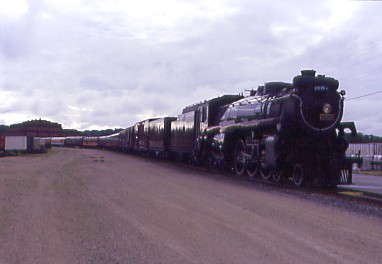
I was up early and well-refreshed as the outside world was enjoying drying conditions. I went to Bakers Square for breakfast then checked out of the Best Western in Minneapolis and the hotel called me a taxi to take me to 2800 Central Avenue, through the gate and into Shoreham Yard where I was dropped off right at the train. This beautiful train had Canadian Pacific Empress 4-6-4 2816, auxiliary tender 35508, Canadian Pacific Railway tool cars 401753 and 29114, Canadian Pacific power car 96, Canadian Pacific coach 101 "Dominion", Canadian Pacific coach 102 "Ernest "Smokey" Smith VC", British Columbia Railway crew sleeper 1711 "Bowen", NSR concession car 9107 "Shoreview", Canadian Pacific business car "Assiniboine", "Caritas" PPCX 800045, "Montana" PPCX 800197 and PPCX 800702 "Lamberts Point".
Those of us who arrived early were boarded at 8:35 AM and a chose a seat with a table in "Dominion" and this would be my base for the next four days. I met Rob Stagg, who was with Canadian Pacific Railway Steam Operations out of Calgary and had conversations with many rare mileage friends as we would all be seeing this line from Shoreham to Portal in the daylight. The people who drove their cars into Shoreham had to move them so they would not intefere with yard operations while we were gone. Releases were turned in and all hands were stamped to signify that we had turned in our releases. The last of the passengers boarded and we were ready to roll to start my first trip behind "Empress", Canadian Pacific 2816.
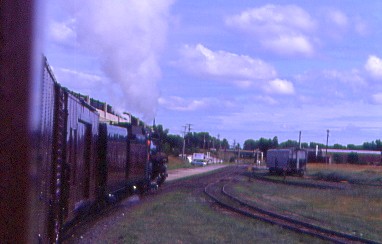
Canadian Pacific 2816 whistled off at 10:00 AM with 70 passengers and we proceeded west to the wye along the BNSF, where we turned north to leave the yard heading and gain access to the Canadian Pacific Railway's main line as my new mileage began. We curved to the west and entered the mainline at University Avenue then crossed over BNSF's Northtown Yard on a long bridge.
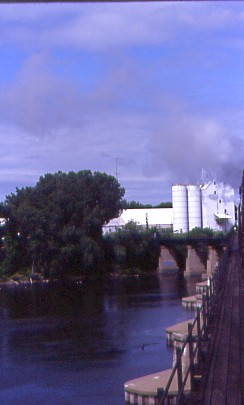
Ccrossed the Mississippi River with a great view looking south towards downtown Minneapolis before crossing Interstate 94 then making our way through the northwest suburbs to Humboldt Yard. We crossed a lake that was linked by a bridge and at Crystal, we crossed the former Great Northern (now BNSF) line that used to go to St. Cloud. but now only goes as far as Monticello. Next we reached the former Minneapolis, Northfield and Southern, now operated by the Twin Cities and Western, then rolled through Plymouth and onto Hamel, where we crossed over Minnesota Highway 55 that would follow our route into North Dakota.
Loram Maintenance of Way, Inc. had their large plant west of town and we had now left urban Minneapolis behind and were out in the lands of farming and forests. Canadian Pacific 2816 reached the town of Loreto with a 7,847 foot siding, the first since Humboldt Yard. Another large lake was off to the south of the train while on Highway 55, the pacers were providing plenty of entertainment. 'Dangerous Dan' from Kansas City was spotted by our passengers then we steamed through Rockford and crossed high over the Crow River, followed by travelling across the green rolling countryside and rolling past the 9,200 foot siding at Dickinson.
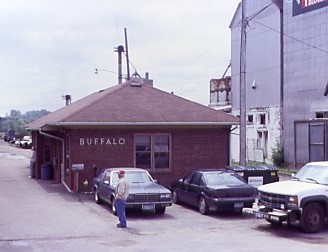
We steamed through Buffalo with the 1953 SOO Line station still standing then ran west into Maple Lake and passed a collection of railroad equipment that Don Lind has assembled, called the Minnesota and Western. I would say that nature has taken over this museum. We continued through Annadale and onto South Haven, with its 8,477 foot siding, then crossed high over Willow Creek before whistling through the town of Kimball, with the Kimball Rail Car Repair facility west of town and stopped in Kimball to service 2816.

We departed at 12:43 PM and the engine provided great sounds as it took off. Highway 55 crossed over to the south side of the tracks and we steamed through Watkins and later Eden Valley. A beautiful lake was off to the north and many more would be seen along our route. Remember, Minnesota has 10,000 lakes! In the 7,651 foot siding at Paynesville was former Conrail 5413 and a Norfolk Southern locomotive waiting for us to clear then Highway 55 crossed over to the right and under the bridge is where a former Great Northern line once crossed our route before we proceeded to Regal. We then crossed the North Fork of the Crow River and went into the siding at Murray for an eastbound freight with SOO Line 6004, Canadian Pacific 8813, Canadian Pacific 9612 and SOO Line 4443, which stopped for ten minutes before it continued east.
He was followed by a Canadian Pacific Railway 5926 East. On the move again, Highway 55 crossed back to the left side of the tracks as we steamed through Belgrade and onto Brooten then train rolled through Sedan, that was named for a city in France where a battle was fought on September 1st, 1870 that led to the establishment of France as a republic.
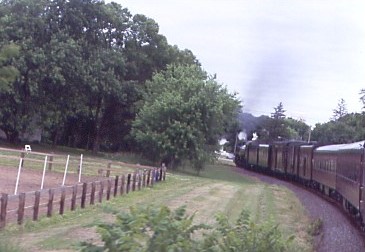
From there, Canadian Pacific 2816 rolled the remaining miles into Glenwood and we were told we could leave our belongings on the train overnight so my wheeled cart and my bag with dirty laundry could stay on the train until Minot. We arrived at Glenwood at 3:10 PM and I took my overnight bag and backpack and after taking some pictures, boarded the school bus to Alexandria with the other 20 people riding all the way through to Portal.
Alexandria 7/7/2004The bus took us the 17 miles to the Holiday Inn where once I checked in, checked my e-mail and went to my room then after relaxing, went to Rudy's Redeye Grill for an excellent ribeye sirloin. That evening, I watched "Finding Nemo" then called it a night and had another excellent night's rest.
7/8/2004 Up early, I cleaned out my e-mail before walking across Interstate 94 to Perkins for French Toast and sausage then checked out of the hotel and the bus arrived at 7:35 AM to take us back to Glenwood.
Canadian Pacific Empress 2816 Day 2 Glenwood to Enderlin 7/8/2004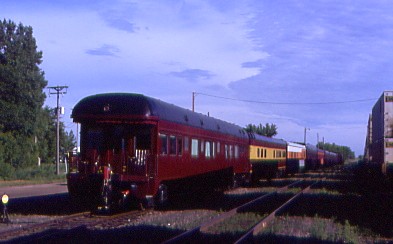
At 9:48 AM, Canadian Pacific 2816 started reversubg up to the mainline in front of the station then at 10:00 AM, it slowly pulled through the yard and after a switch was thrown, we departed Glenwood for good with 26 passengers aboard. We passed the junction with the line to Thief River Falls and crossed Highway 29 as we picked up speed but then slowed to almost a walking speed as we passed a derailment site after MP 125 with tank cars and containers all over the ground north of the tracks. We ran through the rolling landscapes of Lowry and Farewell then steamed through Kensington before crossing the Chippawa River on a fill then reached Hoffman. At Hoffman East, we met Canadian Pacific Railway 9732 East sitting in the siding with a double stack train.
Continuing west, more lakes occupied any low spot on the earth's surface as we ran through a few deep cuts, crossing the North Pomme de Terre before whistling through Barrett with Barrett Lake to the right. Canadian Pacific 2816 steamed into Elbow Lake, a town named for the lake south of town followed by more lakes before traversing Mustinka River and rolling through Wendell. We came down a hill onto a flat plain where there were various forms of farming then continued through Nashua (population 69) and slowed for a yellow at the approach to BNSF's Fargo-to-Wilmar line and the former route of the Empire Builder. There is a wye and interchange track between the BNSF and Canadian Pacific Railway Rail here, after which we made a slight turn to the west and ran to Terry, Minnesota.
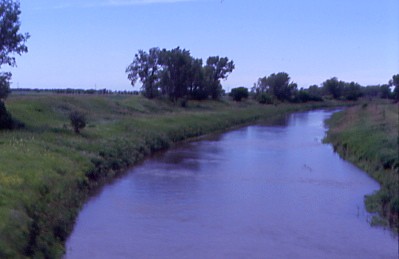
Minutes later, we crossed the Boise de Sioux River to enter North Dakota and leave Minnesota then contiued to Veblem Junction, where to the left, a single unit SOO Line local waited for us to clear. We ran under Interstate 29 before travelling through Oswald with its long siding then into Hankinson, where the steam engine was serviced. The Canadian Pacific crew then announced there would be a photo runby in fifteen minutes which put a smile on all the passengers' faces.
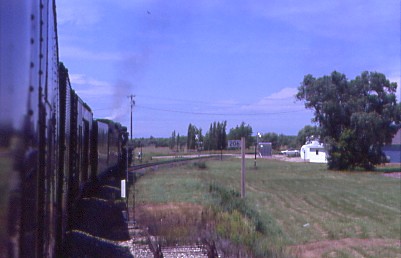
We departed Hankinson at 1:03 PM and turned to the northwest towards Enderlin, our destination for today's trip. Canadian Pacific 2816 crossed the Wild Rice River and slowly rolled into Mantador where we all detrained for the first Canadian Pacific Empress 2816 photo runby in the United States.
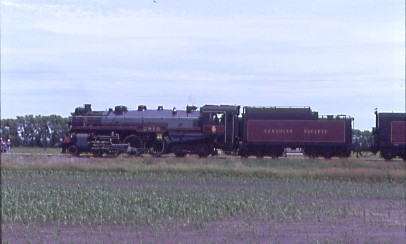
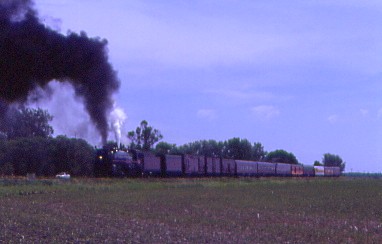
After 2816 reversed, it charged forward much to the delight of all the passengers. Thank you Canadian Pacific Railway! We all said thank you to our fine Canadian Pacific onboard staff then proceeded to run through Moselle and the crew announced a second runby. We stopped short of North Dakota Highway 13 bridge at a grade crossing and detrained once more.
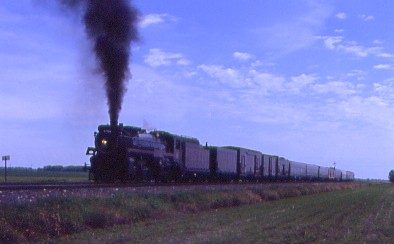
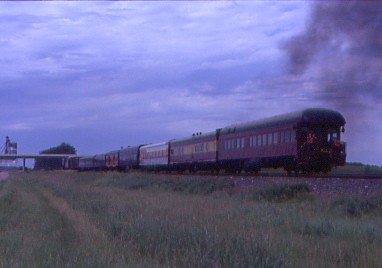
Here Canadian Pacific 2816 performed another fantastic photo runby. Thank you again! Back on the move, we ran through Wyndmere and crossed the Red Valley and Western protected by a small crossing gate. There had been no chasers since we left Hankinson as there was no longer a road paralleling the tracks and would not be rejoining us until tomorrow at Fessenden. We steamed through McLeod with a thunderstorm brewing in the north and it was a sea of grass on both sides of the tracks as we approached Orchid siding before we crossed the Sheyenne River for the first time. North of Anselm, we crossed the RRV&W line at Ransom Junction then steamed the last few miles to Enderlin, where there was with a large ADM plant, ending another fantastic Canadian Pacific Empress 2816 excursion at 3:33 PM. Following a few pictures, I boarded the bus.
The Bus 7/8/2004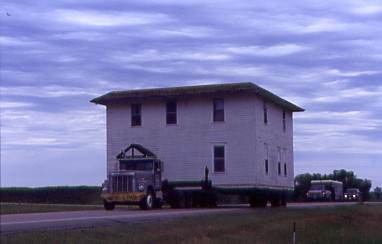
We made our way along North Dakota Highway 45 but a short time later, the driver had to reverse the bus off the road as a full-sized house was westbound down the highway, part of a house convoy. We continued through Kindred to Interstate 29, which we took north to Fargo then turned right on Interstate 94 to Moorehead, where we were dropped off at a Courtyard by Marriott for the night. I went to the restaurant next door and had the worst meal of the whole trip then relaxed the rest of the evening away.
The Bus Back to the Train 7/9/2004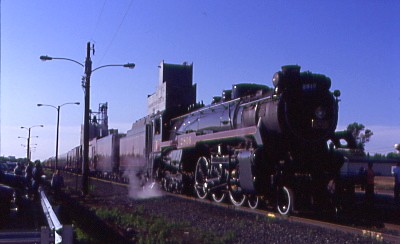
We departed at 7:00 AM and with no houses to contend with, we were back in Enderlin about an hour later. My overnight bag was placed on the train for the final time before pictures were taken around the yard.
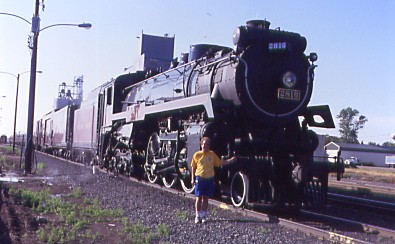
The author and Canadian Pacific 2816, taken by Frank Sandberg.
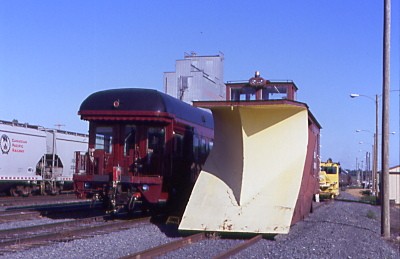
The rear of our train and a SOO Line snow plough.
Canadian Pacific Empress 2816 Day 3 Enderlin to Minot 7/9/2004We departed at 8:59 AM and slowly made our way out of town, receiving track warrants before finally ascending the grade out of town. We picked up speed running to Lucca, where another RRV&W line ran west to Marion. Northwest of there, there was a lake on both sides of the tracks before Fingal then the siding of Eagle was passed before steaming through Cuba, North Dakota. As we passed Siding 280, I was interviewed by Cory from ABC Channel 6 of Fargo, North Dakota then we neared Valley City going under Interstate 94 and descending into the valley.
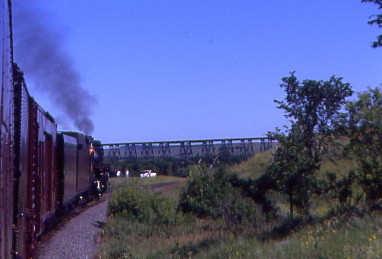
We went under the former Northern Pacific trestle that spanned the whole valley and pulled into Valley City (North Valley), where a few passengers detrained. We were passed by Canadian Pacific 6059 West with former Conrail locomotive along for the ride.
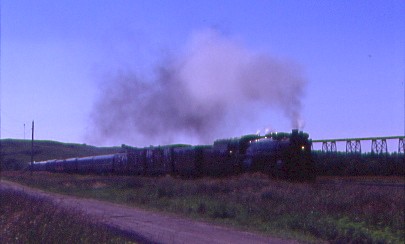
We reversed to the grade crossing where we detrained for a photo runby with the trestle off to the south then once back aboard, Canadian Pacific 2816 started to climb out of Valley City and when we passed the west end of the siding, we crossed Sheyenne River then climbed the steep grade out of the valley as I rode in the vestibule for the entire climb.
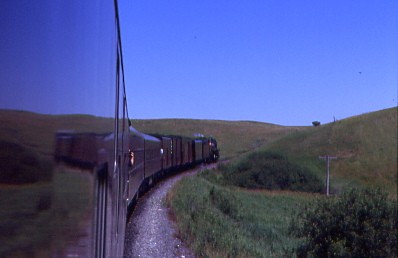
Once on top, our train returned to the flatness of the plain then rolled under North Dakota Highway 1 before passing through Rogers and Wimbledon, where the Midland Continental station and a caboose is on display. West of Courtenay, every low spot had a lake and deer were spotted along our route then we ran down the mainline as we met a Canadian Pacific local in the siding at Kensal. I noted the grain elevator here had a center cab switcher and the steam engine was serviced here.
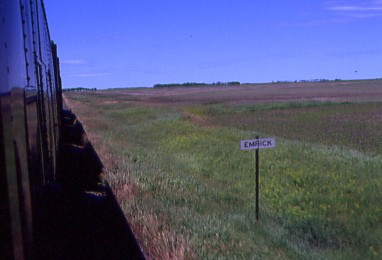
We departed Kensal at 12:32 PM to continue our trip west, crossed James River and twisted and turned to gain elevation as we passed more lakes and a fenced-in elk farm. Another large lake on our right greeted our arrival into Bordulac then after crossing more farmland, we came to Carrington, crossed another RRV&W rail line, this one running north to Maddock, then passed canola fields with their bright yellow leaves before steaming through Cathay then on to Emrick with a siding outside of town.
We proceeded to Fessenden where I saw Bob Riskie filming the train then continued through Manfred before crossing James River and passing a highway sign that read "Continental Divide 1212 Feet". This is the divide between the Atlantic and Arctic Oceans since the Red River of the North flows north into Canada. If you walked this divide west, it would take you to the Triple Divide Peak in Glacier National Park where the north/south Continental Divide intersects this divide. Is North Dakota not an exciting place?! We ran the last few miles into Harvey where Canadian Pacific 2816 was serviced and we were allowed to detrain.

I walked over to the city's park on 7th Street West for SOO Line 2-8-0 440 built by American Locomotive Company in 1900 and retired in 1961.
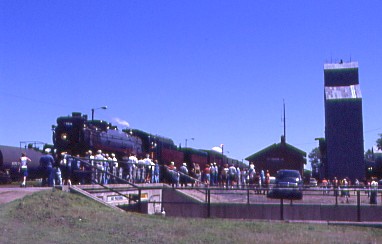
Our train beside the Harvey depot. There is a SOO Line emblem on the bridge.
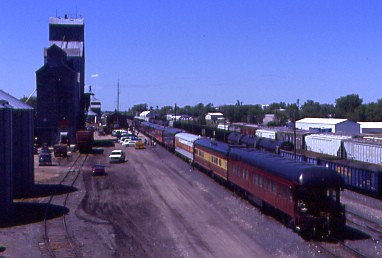
The view from the walkway at the end of the train. I talked to Bob and told him about the change of hotels, but he had made other plans so I would be on my own in Minot for two nights. Bob and his nephew would ride the train tomorrow and planned to board Amtrak in Devils Lake on Sunday.
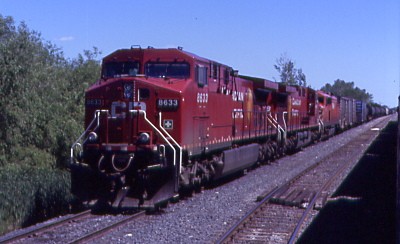
Leaving Harvey, we passed a westbound train then an eastbound Canadian Pacific Railway train refuelling on the mainline. Once we were at track speed, we ran through Martin with Bob filming from the car then climbed the grade to reach Anamoose. Here, we were within four miles of the former Great Northern (BNSF) Surrey cut-off, the main freight line to the northwest. Canadian Pacific 2816 steamed through Drake where we passed a local, as well as the junction of the Canadian Pacific Railway branch to New Town then crossed Wintering River where ranching had taken over as the landscape had become drier. A sea of yellow (canola) was off to the left as we approached Balfour then ran through the tiny community of Bergen then on to Voltaire before travelling through a short valley between the hills to Velva. From here, we would follow the Mouse River all the way to Minot and we passed through Swayer, where we saw the results of another derailment with tank cars on flats and wheels in gondolas. We ran by Logan siding, with a Canadian Pacific Railway double stack train waiting for us to pass and travelled though some forest as we reached the Minot yard limit before ducking under US Highway 2 and reached Siding 466. We stopped in the yard before proceedinig to the team track where the train would lay over for the night before 6:00 PM. That ended another journey behind Canadian Pacific 2816, three trips down, one more to go!
Minot 7/9/2004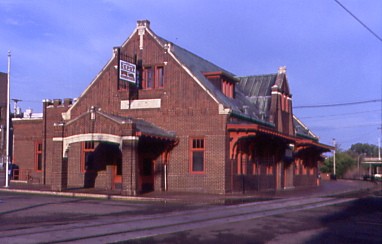
The Soo Line station built in 1912. Passenger train service ended on December 9, 1963, when trains 13 and 14 were discontinued from the Twin Cities to Portal, North Dakota. Mixed train service continued for some time thereafter. The station was listed on the National Register of Historic Places in 1978.
The International hotel shuttle vans were not present so ten minutes after we arrived, Joe Harper found a taxi and three of us took it to the hotel for $2 apiece. I checked in, dealt with my e-mail and later fellow passengers Dave and Lynne walked with me to KFC for dinner, after which I returned to the hotel for a quiet night of television.
Canadian Pacific Empress 2816 Day 4 Minot to Portal 7/10/2004Following the answering of some e-mail, I went to breakfast and found Canadian Pacific 2816 on the front page of the Minot newspaper. Joe and I took the shuttle down to Amtrak and we walked to the train via the Soo Line station. A Canadian Pacific freight passed our steam train and we chatted with Doyle McCormack about various topics. I boarded Canadian Pacific coach 101 "Dominion" for the final time on this trip aboard "Empress", Canadian Pacific 2816.

Bob and his nephew Dale from Forest River, North Dakota, joined me at my table before they left for the open baggage room doors of "Shoreview". At 10:00 AM, Canadian Pacific 2816 started reversing out of the house track to start our journey.
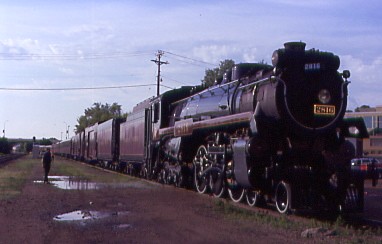
We proceeded through downtown Minot, past the Soo Line depot and under the Broadway bridge then steamed by the Amtrak depot and crossed the BNSF line at Soo tower before crossing Mouse River and out of Minot by a large quarry.
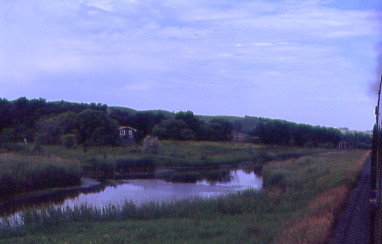
Canadian Pacific 2816 followed Mouse River northwest and then the former Great Northern Gassman trestle, on which I would be riding home on the Empire Builder, came into view. Highway 2 followed our route as far as Burlington, where North Dakota Highway 52 picked up our route. From Burlington, our train would be following the Des Lacs River Valley. We reached the siding at Foxholm and rolled through the town of the same name and later we whistled through Carpio and then it was nine more miles to Donnybrook, then by the siding at Baden.
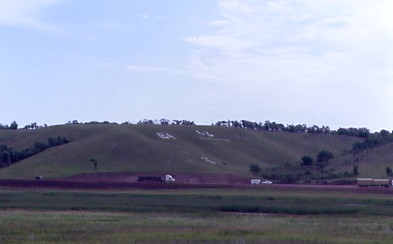
The hills have numbers of high school years of graduations from 1964 to 2004 made out of rocks, which are visible for miles. We ran along Lower Des Lacs Lake then crossed the lowlands before running across the middle of the lake and along the east side of the lake into the town of Kenmare.

Here another photo runby was performed and the sun stayed behind the clouds with Canadian Pacific 2816 putting out the best smoke of any of the runbys so far. We sat for almost a half hour while the tracks ahead of us were inspected.
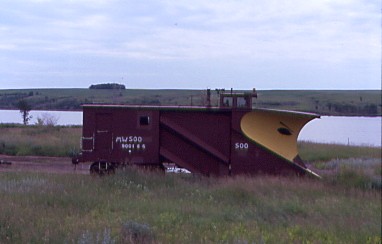
On our way out of Kenmare, here was SOO Line wedge snowplough 500 with a face painted on its front. We steamed by the junction with the North Plains Railroad.
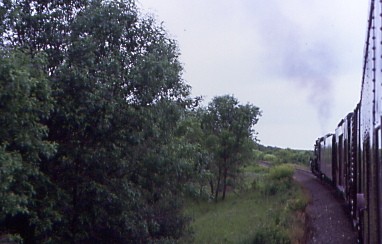
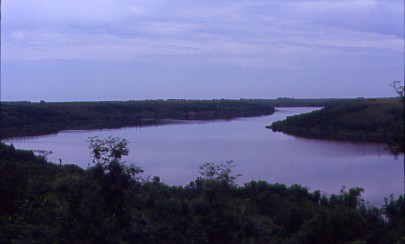
Climbing of the Des Lacs River Valley with the southern end of Upper Des Lacs Lake in the valley below, to a flat plain, where we ran to the siding of Spiral, holding the mainline for Canadian Pacific Railway 9760 East. On the move again, we crossed the BNSF line to Northgate with a Canadian National connection there.
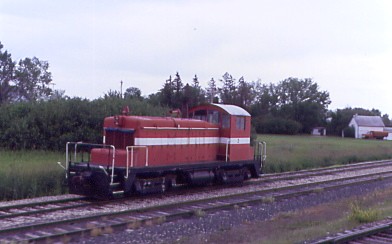
Canadian Pacific 2816 ran though Bowbells where SunPrairie Grain SW-1 2, ex. Farmers United Co-Op Elevator 2, nee St. Joseph Belt Railroad 2, built by Electro-Motive Division in 1950 was sitting to the right of the main line.
Northwest of there, oil wells were spread out across the landscape. We steamed to Flaxton where "Shoreview" was set out then the train reversed onto business car "Assiniboine" before we pulled forward to the switch, reversed "Lamberts Point" onto "Shoreview" and we were set to go. Why did this have to be done here? The track in Portal was not set up to do a move as the non-Canadian Pacific Railway cars would be returning to the Twin Cities from Portal on a freight train. Flaxton is also the junction of a Dakota, Minnesota Valley and Western line and they had a long string a grain cars with a gap with three units sitting, two former Canadian National ones.
We continued by more canola fields, lakes and oil wells as we approached Portal and reached the yard limits before slowly rolling through the yard and by the turntable, then stopped at 2:38 PM, ending my wonderful Canadian Pacific 2816 adventure. The total miles for the last few days' worth of excursion with Milwaukee Road 261 and Canadian Pacific 2816 was 1,601.2 rail miles.

I detrained one happy train rider and photographed the steam engine and the Portal station. From here, I could see Canada just fifty feet away. A special thanks to Canadian Pacific and the Friends of Milwaukee Road 261 for these excellent excursions.
The Bus to Minot 7/10/2004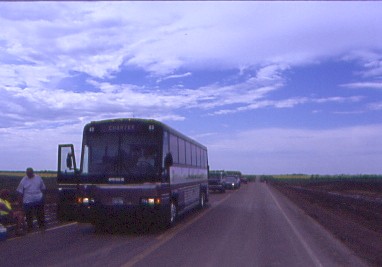
I chose the front seat and Joe joined me. Judy Sandberg thanked all of us and told us about some planned future trips. We left for Minot, stopped to drop off a family in Kenmare then had a delay due to road construction and waited for a pilot car for fifteen minutes before returning to the International Hotel at 5:00 PM.
Minot 7/10/2004I had dinner at the hotel with John Chule of Minneapolis, who rode Milwaukee Road 261 from Milwaukee to Chicago and Canadian Pacific 2816 from Minot to Portal. I watched part of "Atomic Train" with the people taking Amtrak in the lobby and it was good for a few laughs. Once they all took the shuttle to an on-time Amtrak Empire Builder, I called it a night.
| RETURN TO THE MAIN PAGE |